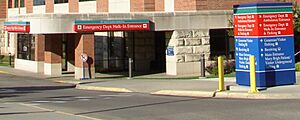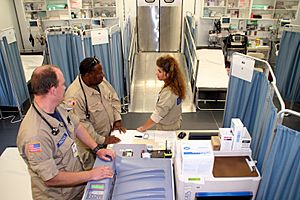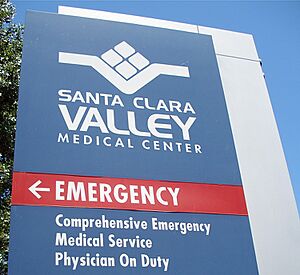Emergency room facts for kids
An emergency room (also called an emergency department or ED) is a special part of a hospital where people go for urgent medical help. It's for when you have a sudden illness or injury that needs quick attention. People often arrive without an appointment, needing immediate care.
The name "emergency department" became popular when doctors started to specialize in emergency medicine. This meant hospitals created special departments just for emergencies. You might also hear it called an 'emergency ward,' 'emergency center,' or 'emergency unit.' In places like the United Kingdom and Ireland, it's often called 'Accident and Emergency' or 'A&E.' In North America, 'emergency room' or 'ER' is still very common.
Contents
When You Need the ED
People go to the emergency department for many different serious health problems. The staff there are trained to handle many kinds of urgent situations quickly.
Heart Problems
Sometimes, a person's heart might suddenly stop working properly. This is called a cardiac arrest. It can happen in the ED, or someone might be brought there by ambulance already in this state. Doctors and nurses immediately start life support to try and restart the heart.
A heart attack happens when blood flow to the heart is blocked. When someone arrives at the ED with a heart attack, they are quickly taken to a special area. They get oxygen and their heart is watched closely. Doctors will do an electrocardiogram (ECG), which checks the heart's electrical activity. They might give medicines like aspirin or pain relievers.
If the ECG shows a serious blockage, doctors need to open the blocked blood vessel right away. This can be done in two main ways:
- Thrombolysis: This uses special medicine to break up the blood clot.
- Angioplasty: This is a procedure where a tiny balloon is used to open the blocked vessel. Sometimes, patients might be moved to another hospital that can do this procedure.
Serious Injuries (Trauma)


Major trauma means a person has many serious injuries, often from things like a car crash or a big fall. The emergency department is the first place these injuries are treated. A special trauma team works together to help these patients. This team uses special training to manage serious injuries.
The ED can provide many services, from taking X-rays and setting broken bones to handling very severe injuries. It's very important for someone with a serious injury or sudden illness to get treatment quickly. Doctors call the first hour after a serious event the "golden hour." Getting help during this time can greatly improve a patient's chance of getting better.
Some smaller hospitals have a helipad near their ED. This is where helicopters can land to bring patients who need very specialized care that the local hospital can't provide. The ED staff will make sure the patient is stable enough to be moved to another hospital.
Mental Health Concerns
Sometimes, people come to the emergency department because they are having a mental health crisis. This means they are feeling very unwell emotionally or mentally. The ED staff will check their physical health first. If someone needs more help, they might be moved to a special psychiatric unit where mental health experts can provide care.
Breathing Problems
People with long-term breathing problems like asthma or chronic obstructive pulmonary disease (COPD) might have sudden, severe difficulty breathing. When this happens, they come to the ED. Doctors give them oxygen and medicines to help them breathe easier. They might also do a chest X-ray or other tests. In very serious cases, they might need help from a machine to breathe.
Special Tools and Training
Emergency departments are different from other parts of a hospital because they need special tools and staff. Patients often arrive in a serious condition and need help very quickly. They might not be able to tell doctors about their health history or allergies. So, ED staff are trained to work fast and effectively, even with limited information.
ED staff also work closely with EMTs and paramedics who bring patients to the hospital. These first responders use special equipment, and the ED doctors and nurses must know how to use and safely remove it. Because of this, doctors can now specialize in emergency medicine, focusing only on urgent care.
Emergency staff, ambulance crews, and firefighters often train together. This helps them work smoothly as a team during emergencies.
Because time is so important, EDs usually have their own diagnostic equipment. Most have X-ray rooms, and many now have CT scanners and ultrasound machines. They might also have a special lab to get quick results for blood tests. This means doctors don't have to wait for equipment in other parts of the hospital, saving valuable time.
Images for kids
See also
 In Spanish: Departamento de Emergencias para niños
In Spanish: Departamento de Emergencias para niños





